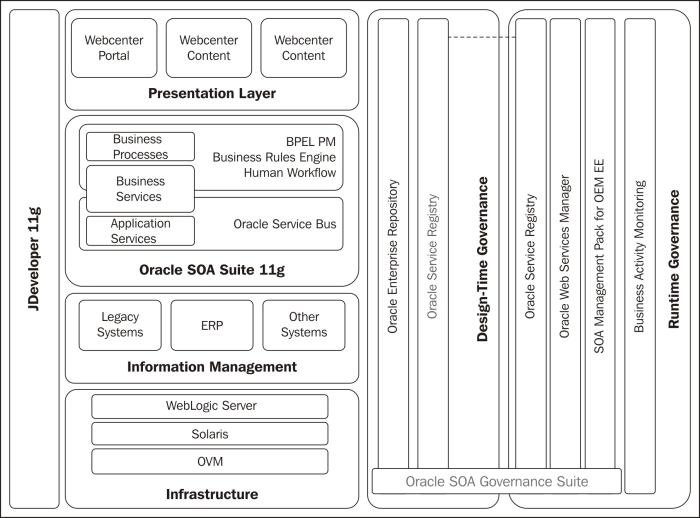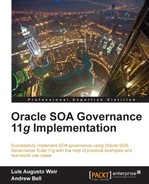The enterprise architecture team began by creating a new reference architecture that would be strongly aligned to the business strategy. This is presented in the following diagram:

The IT strategy was developed with the target operating model in mind including the requirement for new sales channels. The underlying infrastructure was ported to a private cloud-based model to allow for the rapid growth predicted by the business and also in light of expected acquisitions that were due to be made over the coming years. SOA was endorsed as the preferred architectural style for software development with existing and new commercially available and off-the-shelf (COTS) products having little or no customizations moving forward.
Proposed IT developments were assessed and aligned to the IT strategy with a number of projects scrapped and new initiatives introduced.
A new governance process was introduced across the enterprise to reduce redundancy of all software development efforts between business units. A clearly defined SOA Roadmap was created indicating how the current state of the IT organization could move as efficiently as possible to the new To-Be model.
A whole suite of governance standards was created, documented, and distributed to the development teams. These standards clearly specified the development, programming, and deployment standards that were to be adopted for all SOA initiatives enterprise wide.
Design-time governance was introduced, covering all aspects of service discovery, design, versioning, and decommissioning. The Oracle Enterprise Repository was introduced to support design-time Governance by ensuring that all service metadata and XML artifacts were accessible across the enterprise in an effort to promote re-use, and therefore to ensure that key benefits were realized from existing investment in services.
Oracle Enterprise Repository was also used to harvest assets enterprise-wide, ensuring that existing investment was not lost as part of the governance initiative.
Oracle JDeveloper was already used by the development teams for creating services. Integration of the JDeveloper SOA development environment with the Repository and Service Registry was seen as a key requirement to enable developers to access and synchronize between the repository and the development environment to automatically harvest assets and enhance productivity.
Runtime governance standards were defined and documented. A new deployment framework was created to standardize system set up and service deployment. This would enable IT infrastructure to grow efficiently as the business demands increased. Oracle Service Registry was introduced to facilitate rapid discovery and consumption of existing services.
Another key recommendation highlighted as part of the SOA Maturity Assessment was the requirement to improve runtime visibility of SOA assets. As a result, the runtime engines (such as the Oracle Service Registry and Oracle Enterprise Manager) were integrated with Oracle Enterprise Repository to ensure that key metrics around service utilization and service re-use were feedback into the asset's details page. Having design-time and runtime systems integrated, empowered project managers, SOA architects, and designers to enforce policies around service re-use, which ultimately accounted in savings to the company.
Standardized error reporting and system monitoring was introduced with Oracle Enterprise Manager (OEM) being adopted across the enterprise. Business Activity Monitoring (BAM) was also introduced on selected business processes, following a review of business metrics and key performance indicators with the business. Oracle BAM and OEM gave the support team increased visibility into application performance and availability, allowing them to more proactively monitor problems and suggest improvements to a number of key business processes. In some cases, process lifecycles were decreased by as much as 60 percent and cost savings in one area ran into thousands of pounds. This exercise rapidly improved the availability of essential services and processes, which in turn provided a genuine real good factor to the business. The latter was important as the board started to fund further process improvement projects.
Furthermore, continuous integration was implemented so that software was tested regularly ensuring that the quality of software was much higher than had previously been the case.
The SOA Roadmap highlighted further areas of business automation and senior business executives were able to understand and digest how IT could now work hand in hand with the business to introduce real cost savings and to streamline the supply chain further.
The exercise conducted for identifying key business metrics and KPIs also helped the business to focus on important processes that were key to the success of Weir & Bell Telecom. Understanding the business metrics helped the stakeholders to stop and realize a number of business improvements particularly in areas where previously hand-offs between business units were creating unnecessary delays and inefficiencies. Very importantly, IT and the business now had the ability to measure, qualitatively and quantitatively, key business areas, allowing the board for the first time to have a real understanding of the impact of IT investment moving forward. This could range from bottom line costs savings to simply improving the lives of some of its staff by freeing them from tasks that could otherwise be automated, thus freeing them up for more value-added activities.
